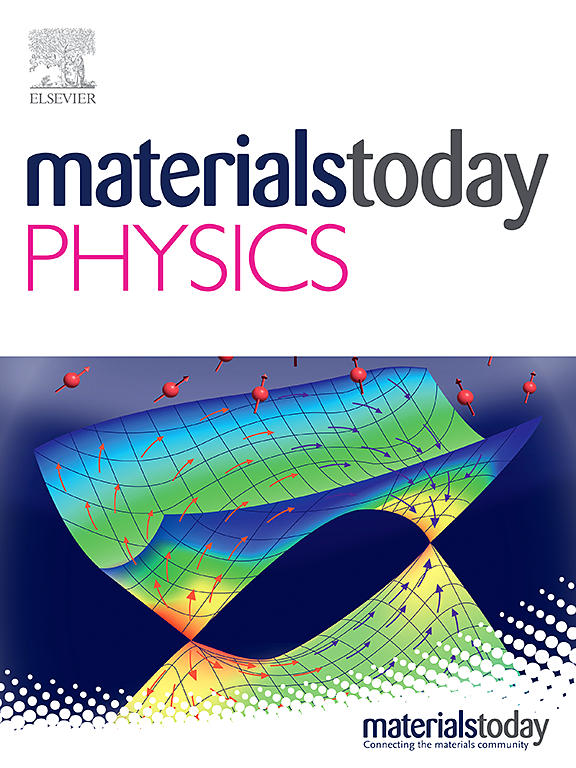Ti-decorated SiC2 as a high-performance anode material for Li-ion batteries: A DFT-D2 approach
IF 10
2区 材料科学
Q1 MATERIALS SCIENCE, MULTIDISCIPLINARY
引用次数: 0
Abstract
This study employs dispersion-corrected DFT-D2 calculations to investigate Li adsorption on pristine and Ti-decorated SiC2, evaluating their potential as anode materials for Li-ion batteries. Key analyses, including adsorption energy, density of states (DOS), Bader charge, diffusion barrier, and open-circuit voltage (OCV), reveal that the incorporation of titanium (Ti) into SiC2 significantly enhances the electrochemical performance, stability, and lithium atom diffusion characteristics of the material. Ti increases the adsorption energy, Eads, from −1.422 eV for SiC2 to −1.641 eV for Ti-decorated SiC2, strengthening the bond between lithium ions and the substrate. This stronger interaction improves capacity retention and cycling stability by reducing lithium desorption during cycling. While this increase in adsorption energy may slightly impede lithium diffusion, it contributes to greater structural stability and durability under high-rate charging and discharging conditions. Additionally, OCV is enhanced from 0.340 V in SiC2 to 0.392 V in Ti-decorated SiC2, improving the overall energy output. The lattice constants exhibit a minimal change of only 0.21 %, indicating that lithium intercalation and deintercalation during battery charge and discharge cycles have an insignificant impact on volume variation. With a capacity of 965.25 mAh/g, Ti-decorated SiC2 achieves a more favorable balance of stability, rate capability, and energy efficiency compared to undoped SiC2, making it a promising material for practical, long-term applications in lithium-ion batteries.
ti修饰SiC2作为高性能锂离子电池负极材料:DFT-D2方法
本研究采用色散校正DFT-D2计算来研究Li在原始和ti修饰的SiC2上的吸附,评估它们作为锂离子电池负极材料的潜力。吸附能、态密度(DOS)、Bader电荷、扩散势垒和开路电压(OCV)等关键分析表明,钛(Ti)在SiC2中的掺入显著提高了材料的电化学性能、稳定性和锂原子扩散特性。Ti增加了SiC2的吸附能Eads,从-1.422 eV增加到-1.641 eV,增强了锂离子与基体之间的结合。这种更强的相互作用通过减少循环过程中的锂解吸提高了容量保持和循环稳定性。虽然这种吸附能的增加可能会稍微阻碍锂的扩散,但它有助于在高倍率充放电条件下提高结构的稳定性和耐久性。此外,OCV从SiC2的0.340 V提高到ti修饰SiC2的0.392 V,提高了整体能量输出。晶格常数变化极小,仅为0.21%,表明电池充放电循环过程中锂的插入和脱嵌对体积变化的影响不显著。与未掺杂的SiC2相比,ti修饰SiC2的容量为965.25 mAh/g,在稳定性、速率能力和能源效率方面取得了更有利的平衡,使其成为锂离子电池中长期实用的有前途的材料。
本文章由计算机程序翻译,如有差异,请以英文原文为准。
求助全文
约1分钟内获得全文
求助全文
来源期刊

Materials Today Physics
Materials Science-General Materials Science
CiteScore
14.00
自引率
7.80%
发文量
284
审稿时长
15 days
期刊介绍:
Materials Today Physics is a multi-disciplinary journal focused on the physics of materials, encompassing both the physical properties and materials synthesis. Operating at the interface of physics and materials science, this journal covers one of the largest and most dynamic fields within physical science. The forefront research in materials physics is driving advancements in new materials, uncovering new physics, and fostering novel applications at an unprecedented pace.
 求助内容:
求助内容: 应助结果提醒方式:
应助结果提醒方式:


